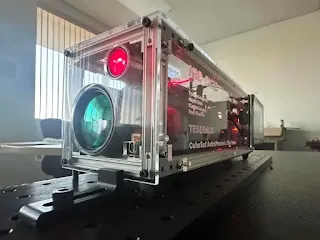 |
| Revolutionizing Space-Based Astronomy with Photonic Chips: Affordable Exoplanet Detection Using CubeSats Image credit: IEEE Spectrum |
Miniaturizing Space Telescopes with Photonic Chips
Astronomers are turning to photonic integrated circuits (PICs) to drive advancements in space-based astronomy, significantly reducing the size, weight, and cost of telescopes. These circuits, which process information using light instead of electricity, are already widely used in data centers but are now being adapted for astronomical purposes. By integrating PICs into space telescopes, researchers aim to replace traditional filters, lenses, and mirrors with chip-based systems, enhancing stability and scalability.
Affordable Exoplanet Detection with CubeSats
CubeSats—small, standardized, and cost-effective satellites—are proving to be an ideal platform for deploying these compact PIC instruments. Ross Cheriton, a photonics researcher at the National Research Council of Canada, along with his team, is working on a CubeSat prototype equipped with a photonic chip. This chip is designed to detect subtle gas signatures during an exoplanet transit, a phenomenon where a planet passes in front of its host star. For a fraction of the cost of traditional space telescopes, CubeSats equipped with PICs could conduct prolonged observations of star systems to identify gases of biological origin in exoplanet atmospheres.
The Power of Miniaturized Spectroscopy
As a proof of concept, Cheriton led a team of undergraduate students in designing a silicon nitride photonic circuit sensor within a custom 3U CubeSat platform. This sensor successfully detected the absorption signatures of CO2 in incoming light. The process involves focusing light through a collimating lens, channeling it through waveguides on the photonic chip, and then using a ring resonator to filter specific wavelengths that correspond to gas absorption spectra. The filtered light is then detected and processed by a Raspberry Pi computer, providing sensitive readings for gas presence.
Next Steps in Astrophotonic Research
While the current design has not yet been space-qualified, the team has successfully tested the sensor in the lab for detecting CO2 using red light. Their next goal is to test the sensor's ability to detect oxygen, using a silicon nitride chip selected for its transparency to oxygen's specific wavelength. Success in this endeavor would mark a significant step toward the ultimate goal: finding Earth-like planets with oxygen-rich atmospheres.
 |
| The sensor being deployed in the lab to detect CO2 using red light Image credit: IEEE Spectrum |
Reducing Barriers to Space-Based Astronomy
The motivation behind this research is to make space-based astronomy more accessible by lowering costs and reducing the complexity of telescope components. With the potential to deploy swarms of lower-cost spacecraft equipped with photonic chips, smaller space telescopes could perform significant scientific observations that were previously only possible with expensive, large-scale missions like the James Webb Space Telescope.
Conclusion: The Future of Space Telescopes
The work of Cheriton and his team represents a promising leap forward in space-based astronomy, offering a cost-effective alternative to traditional telescopes. Their research, presented at the Optica Advanced Photonics conference in July, highlights the potential of photonic chips to revolutionize how we explore the universe, making advanced astronomical research more accessible and affordable than ever before.



.png)






0 Comments